-
The Hard-Wired MCA Era
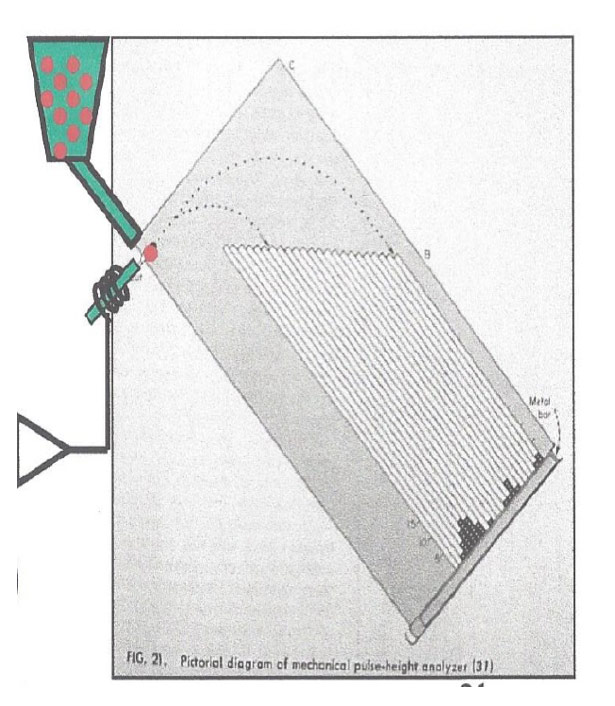 Thanks to Frazier Bronson who painted the hopper and the solenoid on this old illustration.
Thanks to Frazier Bronson who painted the hopper and the solenoid on this old illustration.The history of the Multichannel Analyzer deserves a book of its own and is far beyond the scope of this writing. Suffice it to say that there were many different approaches to the problem of acquiring and recording both the energy and intensity of nuclear radiation. Among these were “swept” single channel analyzers: SCAs with a baseline sweep that slowly and linearly increased the SCA baseline through a range of voltage (energy) with the SCA output feeding a rate-meter hooked up to a chart recorder. Canberra developed such a system for the educational market. There were “stacked” SCAs as well: SCAs with windows set one above another, each representing a channel in the spectrum. One of the most interesting instruments was the “kicksorter”, a British invention whose name lives on today among British scientists of a certain age. The kicksorter was an electromechanical device comprising a plastic slab oriented on a slant with X number of parallel slots or channels and with a solenoid at the top left side and a hopper containing and feeding steel balls into firing position in front of a solenoid. Power to the solenoid was proportional to the height of the drive pulse (energy) and consequently the balls accumulated in the various slots in proportion to intensity. The result was a visual histogram of the spectrum. This invention came from the Cavendish Laboratory and is attributed to Otto Frisch (of the Frisch-grid ionization chamber) and others. Is it possible that the term “channel” in pulse height analysis came from this invention?
Enter Harvey Roberts, The Father of the Canberra MCA
 That’s Harvey with Hugo Cianfaglione (a designer/draftsman)
That’s Harvey with Hugo Cianfaglione (a designer/draftsman)In 1970, Harvey Roberts and the team of engineers who came to Canberra via Geoscience and TMC set about to design a new MCA to replace the two re-badged Geoscience MCAs, the 7000 and the 7010, that went into production as the 8700 and the 8710 at Canberra after the acquisition. The team included Walt Kremser, Joe Hamed, Greg Cox, Ed Cunningham, and George Veilette. Only Harvey and Walt stayed with Canberra until retirement. The Tracor-Northern Econ II was a popular MCA at the time and the 8100 was conceived as an improved version of this instrument. Ironically, one of the reasons Canberra lost the TMC MCA team to Geoscience when TMC folded was that Chuck Greer insisted that they develop a product in the NIM format, like the successful ND 2200, which was built in NIM-like modules. Even if they were not really NIMs, they plugged into a NIM Bin. Harvey wanted nothing to do with this concept and, for this and other reasons, the team went to Geoscience instead of Canberra. Of course there was no question but that the 8100 would be a bench-top instrument.
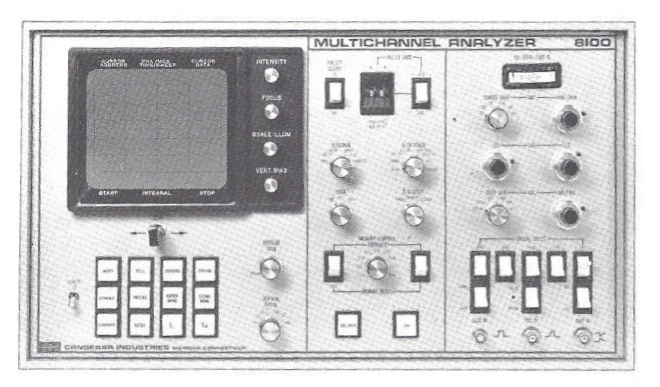 The 8100
The 8100Another controversial issue had to do with the numeric display. The Econ II had a nixie tube display near the CRT to identify the cursor channel. It would have been relatively easy to incorporate this feature in the 8100, but Chuck insisted that we get the numbers on the CRT itself. This new technology required much more engineering effort to implement, but it distinguished the 8100 as truly new and innovative, and undoubtedly helped it become a great success in the marketplace.
The 8180
 The 8180
The 8180The 8180, with an imbedded microprocessor, came out in 1975. Originally conceived by Gerry Matthews and Orren Tench as an MCA for non-dispersive X-ray analysis, before its introduction it was redirected to nuclear applications when Canberra backed away from the X-ray market. Using the 8100 platform, the 8180 provided the option of energy calibration (readout in energy), Isotope ID, and peak markers for isotope confirmation. Steve Piner wrote the firmware for this product and his struggle to squeeze it into the available memory is legendary. This set the stage for standalone MCAs with more capability, even as mini-computers gained a foothold in gamma analysis systems and the software for comprehensive spectrum analysis evolved.
The Omega 1
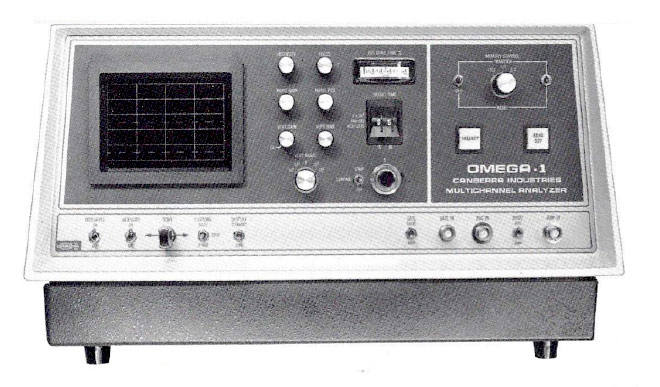 The Omega 1
The Omega 1The Omega 1 was Canberra’s first low cost (1024 channel) MCA. It was also the first time we used the services of an industrial designer for packaging. The result was a “transportable” MCA with a sleek-looking enclosure having a handle build into the cast aluminum bezel. It was quite heavy and the thin, knife-like handle made hand-carrying a painful experience. The Omega 1 came out in 1975 and was far from a great success. So much for industrial design!
The Series 30
 The Series 30
The Series 30The Omega 1 did not fare well against the competition, especially a simple machine from Tracor-Northern. We needed a replacement for the Omega 1 and we somehow got our hands on one of their units with the idea of reverse-engineering it. Reverse engineering is not necessarily synonymous with copying. In a proper implementation it involves putting a product through its paces to see how it behaves, and then designing a new product that does the same thing. It is this method that has enabled companies like AMD make computer chips that are virtually interchangeable with those from Intel. This is what we wanted our engineering department to do, but Harvey Roberts wanted no part of it. Harvey was a purist in this way. He believed that progress best came with a fresh approach and this served Canberra quite well, after all.
Finally Les Daniels took it on and designed the S-30 with assistance from Carl Elsishans. Only Les knows just how scrupulous he was in avoiding outright copying of the Tracor MCA, but he was certainly not deficient in design talent and the only schematics he could ever read were those he scratched out himself. Called upon to help on a technical problem with an instrument of his own design, he always eschewed the nice finished schematics and brought out his originals. He probably didn’t even have schematics for the Tracor unit anyway, so there!
Dick McKernan had begun to use the names of heavenly bodies, Jupiter for example, as product names. Orren gave this project the code name, Little Dipper (for Les Daniels), but the prefix “Series” was adopted for the 30 and for most all of the MCAs to come from Canberra, even if there was no intent to make additional instruments within the ‘series’. Anyway the Series 30 came out in late 1977 and was a great success. It was the first Canberra MCA with a raster-scan display setting the standard for all Canberra MCAs to follow.
The new display technology came as a great relief to virtually everyone at Canberra except Harvey Roberts. For years we complained that the slow refresh rate of our CRT displays led to noticeable flicker, but Harvey simply couldn’t see the flicker and he insisted it wasn’t a problem. It must have been that Harvey was blessed with rods and cones on his retinas that had greater persistence than those of ours!
The Series 80
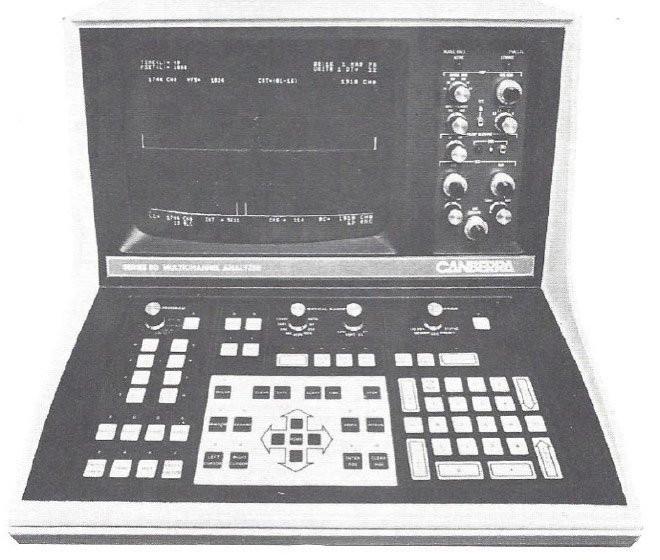 The Series 80
The Series 80In development for several years, the Series 80 came out around 1978. This instrument was by far the most complex stand-alone MCA ever built. It was packaged like a computer terminal with touchpad controls and with a substantial amount of internal computing power that was provided by two micro-processor chips and a “bit-slice processor”, whatever the hell that was. The S-80 had provisions for special front-end modules with the functionality of certain NIMs, but in a non-standard form factor, so these had to be engineered as well. This must have been the most expensive development project that Canberra had ever endured up to that time. Although far from a computer-based MCA, the S-80 had field-installable options for spectrum manipulation, isotope ID, efficiency calibration, and quantitative analysis. By this time Nuclear Data was building mini-computers and programming them to provide MCA functionality while Canberra struggled to engineer ever and ever more complex MCAs. Technically it wasn’t a fair fight, but we did offer customers the comfortable feel of a hard-wired MCA and our sales force made the most of this in their frantic effort to hold market share.
The Series 85
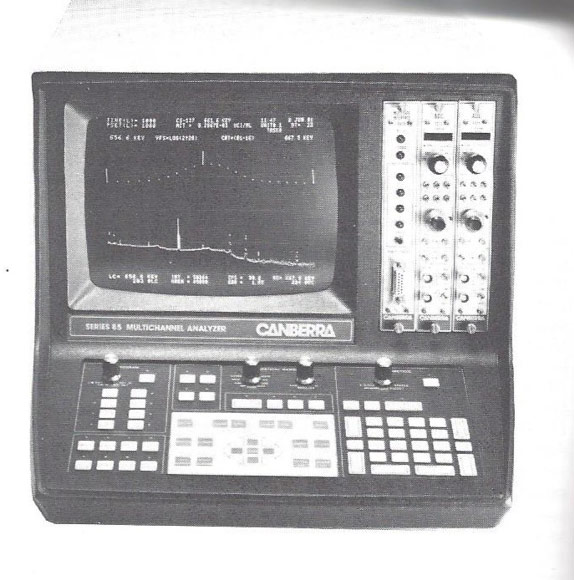 The Series 85
The Series 85The Series 85, an improved version of the S-80, came out within a year or two. The major change involved the use of more nearly standard front end modules (single width NIM-looking units), three of which (ISO one) would fit the available slots in the S-85 chassis.
The Series 40
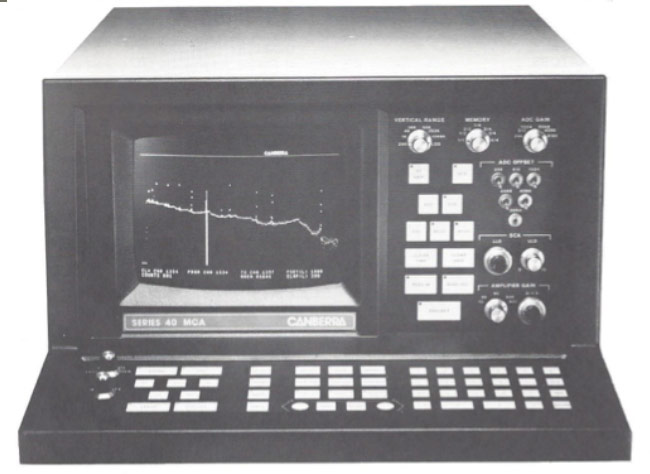 The Series 40
The Series 40The Series 40, a simple 4096 channel MCA was designed to replace the 8100 and 8180. Like the S-80 and S-85 it was packaged to look like a computer terminal, but again with keypad controls instead of a keyboard. This unit was not a great success and was replaced a year or two later by the Series-35 which looked a lot more like a conventional instrument. Experience with the S-80, the S-90, and S-40 led some Canberra cynics, including this writer, to suggest avoiding Canberra MCAs with a zero in the model number.
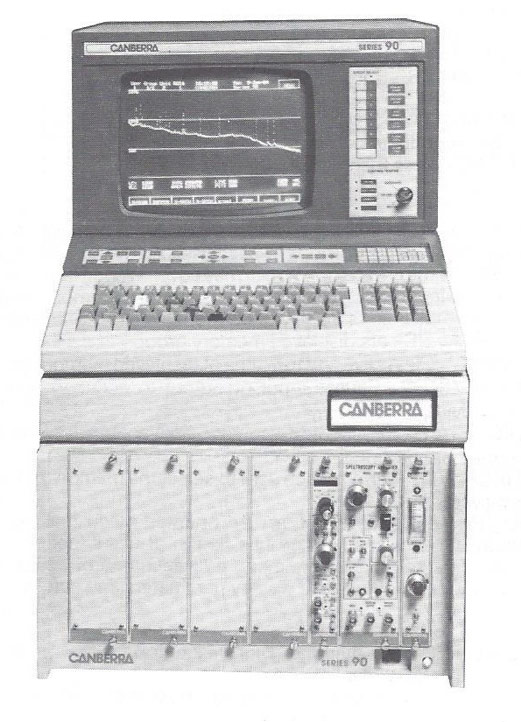 The Series 90
The Series 90The Series 90
The Series 90 was the penultimate complex hard-wired laboratory MCA from Canberra. With a color touch screen display, an industry standard (IEEE 796) bus structure, a 16 bit microprocessor, and a real keyboard, it came close to being a real computer-based MCA, but not quite. At least it made use of standard NIM front end modules instead of the ersatz NIMs required by the S-80 and S-85.
There were problems with the touch-screen display, both technical and legal. A patent holder in this field threatened to sue, not just the supplier, but the customers of the supplier including Canberra as well.
The Series 95
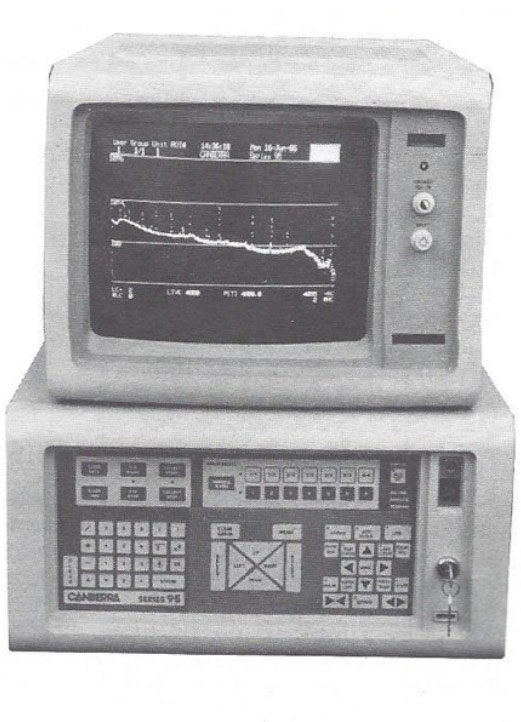 The Series 95
The Series 95For whatever reasons, the last of its kind, the Series 95 was introduced not a lot later. Presumably a better version of the S-90 (again the curse of the zero), this product made use of a store-bought (IBM) color monitor (not touch-screen) and a simpler chassis for the electronics.
The Series 35 and 35 Plus
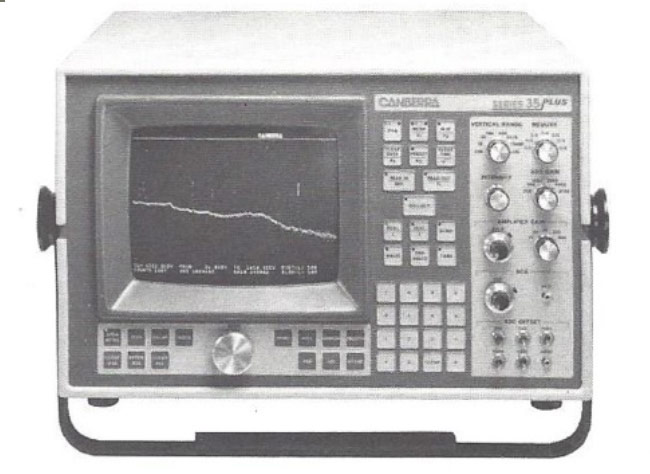 The Series 35
The Series 35By the early 1980s the Series-40 was replaced by the Series 35, which was basically a re-packaged S-40. It had a toggle-switch cursor control like earlier Canberra MCAs. The Tracor-Northern counterpart soon came out with a neat little wheel control that made it much easier to move the cursor faster or slower. Mike Charland designed a similar controller for Canberra and this was enough to warrant a new model number, the S-35 Plus, which became a very popular instrument, maybe the best-selling MCA from Canberra of all time.
The Series 20
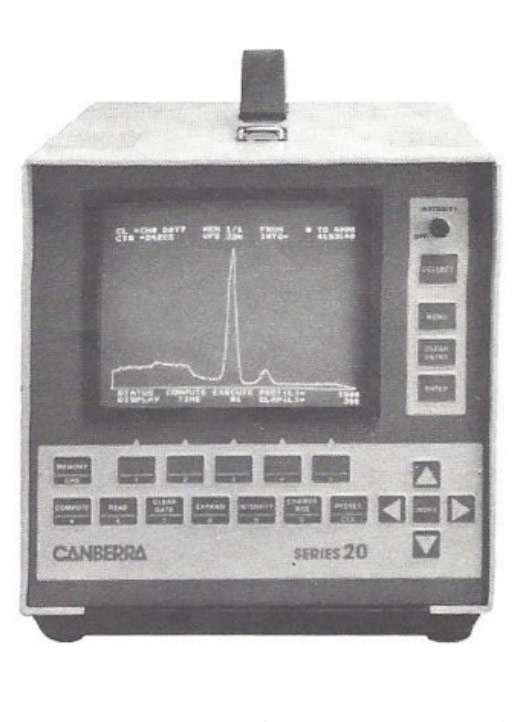 The Series 20
The Series 20A low cost, simple MCA, the S-20 also came out at about the same time as the S-35 Plus. This MCA had relatively limited analysis capabilities and was aimed at educational and nuclear medicine applications.
The Series 10
 The Series 10
The Series 10The first Canberra portable MCA, the S-10 was designed to compete with the very successful ND-6 as well as a small MCA made by Don Davidson, who had once been the MCA guru at TMC. Harvey Roberts probably worked for Don Davidson there. Davidson had connections at the IAEA in Vienna, and he designed his MCA to meet their requirements (and their whims). Consequently, he sold a ton of these units to the Agency and to other customers who were under the influence of the Agency. The S-10 did not go over well there, maybe because of the NIH syndrome, but we did sell a lot of them for emergency response. Our Norwegian representative was famous for selling lots of units in that country (to check reindeer meat post-Chernobyl). The liquid crystal display was novel in its time but it was difficult to see.
The Inspector
 The Inspector
The InspectorThe last in the long series of MCAs that were developed under the watchful eye of Harvey Roberts, the Inspector came out in 1997, the same year that Harvey retired. The inspector included a HVPS, a spectroscopy grade amplifier, and a PC (Laptop) provided the operator interface. With dual (hot-swappable) camcorder batteries the unit could operate continuously. As the operator interface and analysis software were provided by a PC, the inspector was not technically a hard-wired standalone MCA.
The Inspector was a very popular instrument and by 2000, several variations on the unit had been introduced. These included the NaI Inspector (for scintillation detectors), the Desktop Inspector (for laboratory use) and the U-Pu Inspector, a system conceived by Jan Verplancke and Orren Tench that included a novel portable Ge detector with internal tungsten shielding. Using Ray Gunnink’s MultiGroup Analysis (MGA) software, the U-Pu Inspector was ideal for Uranium enrichment analysis and for plutonium isotopics, both key safeguards measurements.